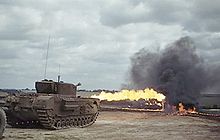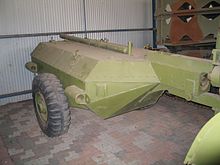- Churchill Crocodile
-
Churchill Crocodile 
Churchill Crocodiles during the Second World WarType Infantry tank/Flame tank Place of origin  United Kingdom
United KingdomService history In service (British Empire) Used by  United Kingdom
United KingdomWars Second World War Specifications Main
armamentOrdnance QF 75 mm Secondary
armamentFlame thrower The Churchill Crocodile was a British flame-throwing tank of late Second World War. It was a variant of the Tank, Infantry, Mk VI (A22) Churchill Mark VII, although the Churchill Mark IV was initially chosen to be the base vehicle.
The Crocodile was introduced as one of the specialised armoured vehicles developed under Major-General Percy Hobart, informally known as "Hobart's Funnies". It was produced from October 1943, in time for the Normandy invasion.
Contents
Design and development
From early in the war, there had been experiments with mounting flamethrowers on British vehicles; leading to vehicles such as the Cockatrice, Basilisk and the Wasp (the latter being a flamethrower on a Universal Carrier). The Churchill Oke, a flamethrower carrying Churchill Mark II developed by a Royal Tank Regiment officer, was tested operationally on the Dieppe Raid. Parallel development work was carried out by the Petroleum Warfare Department, AEC and the Ministry of Supply (MoS) on Valentine tanks. The Department of Tank Design preferred the Churchill, which was the Infantry tank successor to the Valentine, as a basis for further work.[1]
General Percy Hobart saw the Crocodile demonstrated in 1943 and pressured the MoS to produce a development plan[2] and the Chief of the General Staff added the flamethrowers to the 79th Division plan.
Final design
The flamethrower equipment was produced as a kit that REME workshops could fit in the field, converting any available Churchill Mk VII. The conversion kit consisted of the trailer, an armoured pipe fitted along the underside of the tank, and the projector, which replaced the hull mounted Besa machine gun. The Crocodile was therefore still able to function as a gun tank with its turret mounted Ordnance QF 75 mm gun.
Of the 800 kits produced, 250 were held in reserve for possible operations against the Japanese.[3] The remainder was sufficient for producing three regiments of tanks as well as training and replacements for battlefield casualties.
400 imperial gallons (1,800 l) of fuel[4] and the compressed nitrogen propellant, enough for eighty[5][6] one-second bursts, were stored in a 6½ ton detachable armoured trailer towed by the Crocodile. The trailer, connected to the tank by a three way armoured coupling,[7] could be jettisoned from within the tank if necessary.
Flame projector
The thrower had a range of up to 120 yards[8] (some sources quote 150 yards[9][10]). The pressure required had to be primed on the trailer by the crew as close to use as feasible, because pressure could not be maintained for very long. The fuel was used at 4 gallons per second; refuelling took at least 90 minutes and pressurization around 15 minutes. The fuel burned on water and could be used to set fire to woods and houses. The flamethrower could project a "wet" burst of unlit fuel which would splash around corners in trenches or strongpoints and then ignite this with a second burst.
Service
Used by units of the 79th Armoured Division in concert with the Churchill AVRE, and other Funnies, the Crocodile was an effective assault weapon whose threat could induce enemy troops to retreat or surrender. The Crocodile was a specialised weapon, best used against suitable targets and it was limited by the short range of its flamethrower. On the other hand, it was used so successfully against bunkers that many bunkers surrendered after the first ranging shots. Aspects of the mechanism were considered by the British to be so secret that disabled units, if they could not be recovered, were rapidly destroyed by any means, even air strike,[citation needed] if necessary.
British Crocodiles supported the U.S. Army in the Normandy bocage and, later, during Operation Clipper, the Anglo-American assault on Geilenkirchen. C Squadron also supported the 53rd Welch Division assault on s`Hertogenbosch in October 1944.
The units that used the Crocodile were in Europe, the 31st Armoured Brigade:
- 1st Fife and Forfar Yeomanry
- 141st Regiment Royal Armoured Corps (The Buffs, Royal East Kent Regiment)13th Troop C squadron 141 RAC saw action on the first day of the Normandy invasion.
- 7th Royal Tank Regiment
In Italy the 25th Armoured Assault Brigade operated Crocodiles.[11]
Surviving vehicles
Mark VII Crocodiles are owned by the Muckleburgh Collection in Norfolk, the Cobbaton Combat Collection in Devon, the D-Day museum in Portsmouth, the Wheatcroft Collection, the Kubinka Tank Museum in Russia and the Museum of the Regiments, Calgary, Alberta. A Mark VIII is at the Royal Australian Armoured Corps Museum. Two (one in running order) are privately owned in the UK. One example, without trailer, on display at the Bayeux Museum of the Battle of Normandy and a trailer is held at the Bovington Tank Museum.
Notes
- ^ David Fletcher Churchill Crocodile Flamethrower Osprey Publishing, 2007
- ^ Churchill's secret weapons p 71
- ^ Churchill's secret weapons p 72
- ^ The Encyclopedia of Tanks and Armored Fighting Vehicles - The Comprehensive Guide to Over 900 Armored Fighting Vehicles From 1915 to the Present Day, General Editor: Christopher F. Foss, 2002
- ^ Fortin, Ludovic. British Tanks In Normandy, Histoire & Collections. ISBN 2-91523-933-9
- ^ Fowler, Will. D-Day: The First 24 Hours, Lewis International Inc. ISBN 1-930983-22-0
- ^ The coupling coped with Yaw, pitch, and roll of the trailer with respect to the tank
- ^ Fowler gives a range of 80-120 m (73-110 yards), Fortin gives a range of 70-110 m (64-100 yards)
- ^ How We Blasted the Huns with Flame in France, The War Illustrated, September 29, 1944
- ^ Equipment used by the Armoured Brigades
- ^ Crow, D Tanks of World War II 1979
References
- Delaforce, Patrick (2006). Churchill's Secret Weapons: the story of Hobart's Funnies. Barnsley: Pen & Sword. ISBN 1 84415 464 5.
- Equipment used by the Armoured Brigades
- Photos of the D-Day Museum Crocodile
External links
Light tanks Cruiser tanks Mk I · Mk II · Mk III · Mk IV · Mk V Covenanter · Mk VI Crusader · Mk VII Cavalier · Mk VIII Centaur · Mk VIII Cromwell · Challenger · Comet · Sherman Firefly · Ram (Canada) · Grizzly I (Canada) · Sentinel (Australia)Infantry tanks Scout Cars and Armoured carsScout Cars Daimler Dingo • Dingo Scout Car (Australia) • Humber Scout Car • Lynx Scout Car (Canada) • S1 Scout Car (Australia)Light Reconnaissance Cars Armoured Cars AEC Armoured Car • Coventry Armoured Car • Daimler Armoured Car • Fox Armoured Car (Canada) • Guy Armoured Car • Humber Armoured Car • Lanchester Armoured Car • Marmon-Herrington Armoured Car (South Africa) • Morris CS9 • Rhino Heavy Armoured Car (Australia) • Rolls-Royce Armoured Car • Rover Light Armoured Car (Australia) • Standard Beaverette • Armoured Carrier Wheeled Indian Pattern (India)Armoured Trucks Bedford OXA • Armadillo • Bison • C15TA Armoured Truck (Canada) • Leyland Beaver-EelArmoured Command Vehicles Experimental vehiclesAvenger • Black Prince • Centurion • Excelsior • TOG 1 • TOG 2 • Tortoise • Valiant • Harry Hopkins • Alecto • Glanville Fighter Car • Morris Motors Salamander • Hillman Gnat • Schofield tank (New Zealand)Unarmoured vehiclesArtillery tractors Trucks and lorries Bedford QLD • Austin K2 • Morris 15 cwt • Austin K5 • Bedford OYD • Bedford OXD • Morris C9 • Guy Ant • Leyland Retriever (3-ton) • Leyland Lynx (30-cwt) • Leyland Hippo (10-ton) • Thornycroft Nubian • Thornycroft TartarTank transporters Utility and cars British armoured fighting vehicle production during World War II Categories:- Infantry tanks
- World War II tanks of the United Kingdom
- Vauxhall vehicles
Wikimedia Foundation. 2010.



